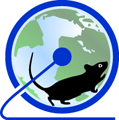International Knockout Mouse Consortium
 | |
|---|---|
| Content | |
| Description | International Knockout Mouse Consortium |
| Organisms | Mice |
| Contact | |
| Research center | The Jackson Laboratory & The Wellcome Trust Sanger Institute |
| Primary citation | Ringwald & al. (2011)[1] |
| Release date | 2010 |
| Access | |
| Website | http://www.knockoutmouse.org |
| Miscellaneous | |
| License | Creative Commons Attribution 2.0 |
The International Knockout Mouse Consortium (IKMC) is a scientific endeavour to produce a collection of mouse embryonic stem cell lines that together lack every gene in the genome, and then to distribute the cells to scientific researchers to create knockout mice to study.[2][3] Many of the targeted alleles are designed so that they can generate both complete and conditional gene knockout mice.[3][4]
The IKMC was initiated on March 15, 2007 at a meeting in Brussels. By 2011, Nature reported that approximately 17,000 different genes have already been disabled by the consortium, "leaving only around 3,000 more to go".[2]
The consortium encompasses four major, high-throughput gene-targeted mutagenesis programs: the National Institutes of Health (NIH)-sponsored Knockout Mouse Program (KOMP) and state-funded Texas Institute for Genomic Medicine (TIGM) in the U.S., the North American Conditional Mouse Mutagenesis (NorCOMM) Program in Canada, and the European Conditional Mouse Mutagenesis (EUCOMM) Programme in Europe.[3][5] The first of its annual meetings of members and funders, hosted by the country of its rotating chair, was held at the NIH in Bethesda, Maryland in the United States for 2007–2008, with Toronto, Canada hosting for 2008–2009.
References
^ Ringwald, Martin; Iyer Vivek; Mason Jeremy C; Stone Kevin R; Tadepally Hamsa D; Kadin James A; Bult Carol J; Eppig Janan T; Oakley Darren J; Briois Sebastien; Stupka Elia; Maselli Vincenza; Smedley Damian; Liu Songyan; Hansen Jens; Baldock Richard; Hicks Geoff G; Skarnes William C (Jan 2011). "The IKMC web portal: a central point of entry to data and resources from the International Knockout Mouse Consortium". Nucleic Acids Res. England. 39 (Database issue): D849–55. doi:10.1093/nar/gkq879. PMC 3013768. PMID 20929875..mw-parser-output cite.citationfont-style:inherit.mw-parser-output .citation qquotes:"""""""'""'".mw-parser-output .citation .cs1-lock-free abackground:url("//upload.wikimedia.org/wikipedia/commons/thumb/6/65/Lock-green.svg/9px-Lock-green.svg.png")no-repeat;background-position:right .1em center.mw-parser-output .citation .cs1-lock-limited a,.mw-parser-output .citation .cs1-lock-registration abackground:url("//upload.wikimedia.org/wikipedia/commons/thumb/d/d6/Lock-gray-alt-2.svg/9px-Lock-gray-alt-2.svg.png")no-repeat;background-position:right .1em center.mw-parser-output .citation .cs1-lock-subscription abackground:url("//upload.wikimedia.org/wikipedia/commons/thumb/a/aa/Lock-red-alt-2.svg/9px-Lock-red-alt-2.svg.png")no-repeat;background-position:right .1em center.mw-parser-output .cs1-subscription,.mw-parser-output .cs1-registrationcolor:#555.mw-parser-output .cs1-subscription span,.mw-parser-output .cs1-registration spanborder-bottom:1px dotted;cursor:help.mw-parser-output .cs1-ws-icon abackground:url("//upload.wikimedia.org/wikipedia/commons/thumb/4/4c/Wikisource-logo.svg/12px-Wikisource-logo.svg.png")no-repeat;background-position:right .1em center.mw-parser-output code.cs1-codecolor:inherit;background:inherit;border:inherit;padding:inherit.mw-parser-output .cs1-hidden-errordisplay:none;font-size:100%.mw-parser-output .cs1-visible-errorfont-size:100%.mw-parser-output .cs1-maintdisplay:none;color:#33aa33;margin-left:0.3em.mw-parser-output .cs1-subscription,.mw-parser-output .cs1-registration,.mw-parser-output .cs1-formatfont-size:95%.mw-parser-output .cs1-kern-left,.mw-parser-output .cs1-kern-wl-leftpadding-left:0.2em.mw-parser-output .cs1-kern-right,.mw-parser-output .cs1-kern-wl-rightpadding-right:0.2em
^ ab Dolgin E (June 2011). "Mouse library set to be knockout". Nature. 474 (7351): 262–3. doi:10.1038/474262a. PMID 21677718.
^ abc van der Weyden L, White JK, Adams DJ, Logan DW (2011). "The mouse genetics toolkit: revealing function and mechanism". Genome Biol. 12 (6): 224. doi:10.1186/gb-2011-12-6-224. PMC 3218837. PMID 21722353.
^ Skarnes WC, Rosen B, West AP, Koutsourakis M, Bushell W, Iyer V, et al. (2011). "A conditional knockout resource for the genome-wide study of mouse gene function". Nature. 474 (7351): 337–42. doi:10.1038/nature10163. PMC 3572410. PMID 21677750.
^ International Mouse Knockout Consortium (2007). "A mouse for all reasons". Cell. 128 (1): 9–13. doi:10.1016/j.cell.2006.12.018. PMID 17218247.
External links
- International Knockout Mouse Consortium
- Knockout Mouse Project (KOMP) Repository
- North American Conditional Mouse Mutagenesis (NorCOMM) Program
- European Union Conditional Mouse Mutagenesis (EUCOMM) Programme
- Texas Institute for Genomic Medicine (TIGM)
